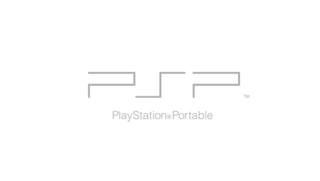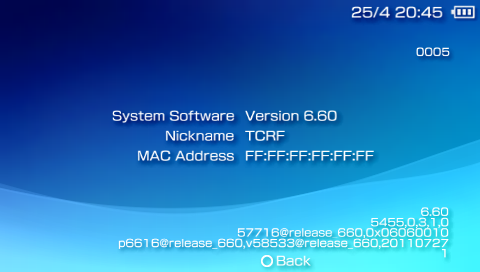PlayStation Portable
| PlayStation Portable |
|---|
|
Developer: Sony Computer Entertainment
|
| This page is rather stubbly and could use some expansion. Are you a bad enough dude to rescue this article? |
| This game/console's online features are no longer supported. While this game/console's online features were once accessible, they are (as of July 6, 2021) no longer officially supported and online-exclusive features may be documented as now-unseen content. |
The PlayStation Portable (abbreviated PSP) is one of two handheld consoles released by Sony, and is the only one that wasn't a flop.
A system ahead of its time, it boasted incredible power for a handheld system, a vast array of multimedia and networking features, a digital storefront for buying games, and, of course, the ability to play a wide range of games, including PS1 games. Unfortunately, it also came with iffy battery life, the shoddy UMD (Universal Media Disc) optical disc format, expensive Memory Stick storage media and a sad excuse for an analog stick.
Many had predicted at the time that the PSP would end Nintendo's dominance of the handheld market. Unfortunately, the massive success of the Nintendo DS meant that the system could not do just that, though it still did sell very well, and hosted a very robust homebrew community, especially compared to other systems. While it may not have toppled Nintendo's handheld empire, it actually came closer than other non-Nintendo handhelds, selling nearly 45% as many units as the DS by 2010. A successor, the PlayStation Vita, followed in 2011, but after the flop of that system, Sony abandoned the handheld market.
Many hardware revisions were released for it, usually incremental ones that improved build quality, battery life and added features. Besides the default PSP systems, there was also the PSP Go, a digital-only redesign that lacked the UMD drive and forced players to depend on downloading their games, and the Europe-exclusive PSP Street, an curious revision that stripped out all wireless networking functionality and cut back a few features.
It's also like a nut you can play with outside.
Sub-Page
| Prototype Info |
| Build Info |
Hidden Firmware Info
Extended information about the installed PSP firmware can be found on the main System Information screen. To access this menu, from the PSP main menu:
- Go to Settings, System Settings, System Information.
- Hold L + R + Left + Square for at least three seconds.
- Release those buttons, then immediately hold Start.
Internally this information is stored as colon separated data, where it will display anything between the 1st and 2nd colon on each line. The 1st column is the name of the line, and the last column is for additional information. As an example, from the final firmware released on PSP, 6.61:
| Internal Data | Displayed Data |
|---|---|
| release:6.61: build:5553,0,3,1,0:builder@vsh-build6 system:58401@release_661,0x06060110: vsh:p6621@release_661,v58692@release_661,20141113: target:1:WorldWide |
6.61 5553,0,3,1,0 58401@release_661,0x06060110 p6621@release_661,v58692@release_661,20141113 1 |
Version Differences
Hardware
There are five major models of the PSP:
- 1000 series "Fat": The original.
- Built like a tank, with significant internal metal framing, save for the cover for the battery compartment.
- UMD drive is built with a tray that requires the UMD disc to be clicked into before closing the door. It is opened with a slider switch on the top of the system.
- Bottom-facing speakers with air intakes on the front.
- Wi-Fi switch is on the left side of the system and is not marked.
- Separate PCBs for the motherboard and Memory Stick/Wi-Fi/headphone jack.
- Infrared sensor on the top of the system, which was never really officially used by Sony and only by homebrew.
- Connector features both the standard headphone jack and pressure-fit pins intended for a dock. No such official product was released.
- 1000K series "Value Pack": A PSP-1000 bundled with a comprehensive set of accessories.
- 2000 series "Slim & Lite":
- Thinner and lighter, exactly as it says on the tin! Back humps removed in favor of a new flatter design.
- UMD drive is now pull-to-open and discs are directly dropped into the works.
- Front-facing speakers.
- The analog stick, which could be easily removed in the 1000 series, was revised to now require the system to be disassembled to be removed. This also deters the stealing of the analog stick. The actual encoder has also been changed to screw into the motherboard instead of the front case, which tends to reduce drift due to imperfect connections.
- New, thinner battery (PSP-S110) with a matching and incompatible cover; an adapted version of the older type was later released, to cater to users of the bigger and higher capacity ones (PSP-110).
- Main memory has been doubled to 64MB for the purpose of UMD disc caching to reduce load times. This also allows the Internet browser to display pages without running out of memory.
- The infrared sensor was removed and in its place is the Wi-Fi switch, which is now labeled.
- Headphone jack moved to the bottom of the system and the connector now supports cables that allow the system to connect to an external TV display. This feature supports YPbPr and composite, though PSP games and applications display only in progressive scan through YPbPr cables.
- Darker Hold "LED" (actually a colored plastic disc) due to deeper positioning.
- Added more color themes to the XMB than the standard 12.
- Added charging over mini-USB, although at a reduced speed and requires the system to exclusively be in USB Connection mode.
- 3000 series "Brite":
- Metal ring on UMD disc door made thinner.
- Home button rebranded as PS button. Buttons below screen changed from semicircular to ovalized rectangle shape.
- Internal microphone added next to the volume buttons, allowing voice chat and Skype out of the box.
- This revision has a new LCD screen that can display sharper, more vibrant colors, though it suffers from interlacing-like artifacts during motion.
- External display feature now supports 480i composite output for PSP games.
- 3000 (Monster Hunter Portable 3 bundle): a limited edition notable for having a thicker back design reminiscent of the 1000 series (complete with large battery as standard) and a different analog stick in the attempt to improve comfort.
- N1000 series "Go": The premium pocketable product.
- Sliding design, complete with clock screensaver.
- Digital-oriented model, famously lacking an UMD drive.
- 16GB internal storage, which can be complemented by a Micro Memory Stick (M2 card). Nominally non-user-replaceable battery.
- Single proprietary connector for power/USB/video. An adapter, the PSP-N440, allows the use of accessories that require the mini-USB connector, such as the camera, GPS, or 1-Seg tuner.
- Bluetooth feature for headphones, tethering, and the use of PS3 controllers (requires a PlayStation 3 console or a tedious unofficial procedure to setup). This is the only PSP model to support two analog sticks and rumble.
- Save state feature for freezing a game and returning to the XMB to play media or use the browser without losing progress. However, it can only save one game state at a time.
- E1000 series "Street": A low cost model that, like the Wii Mini a few years later, managed to not be a total failure despite having a globally limited release, basically no advantages over the previous models (often available on the used market for less), and a lacking modding scene for the better part of a decade.
- Mono speaker, no wireless, no brightness/mute buttons, no video output.
- Buttons below screen redesigned as a fake touch bar.
- Single, extra wide backplate for both UMD and battery (not sold separately).
- Memory stick slot and LEDs on top, power/hold switch on bottom.
- And a lot more internal revisions!
- Pages missing developer references
- Games developed by Sony Computer Entertainment
- Pages missing publisher references
- Games published by Sony Computer Entertainment
- Pages missing date references
- Games released in 2004
- Games released in December
- Games released on December 12
- Games with debugging functions
- Games with revisional differences
- Stubs
- Defunct online content
- PlayStation Portable games
- BIOS/Firmware ROMs
Cleanup > Pages missing date references
Cleanup > Pages missing developer references
Cleanup > Pages missing publisher references
Cleanup > Stubs
Games > BIOS/Firmware ROMs
Games > Defunct online content
Games > Games by content > Games with debugging functions
Games > Games by content > Games with revisional differences
Games > Games by developer > Games developed by Sony Corporation > Games developed by Sony Interactive Entertainment > Games developed by Sony Computer Entertainment
Games > Games by platform > PlayStation Portable games
Games > Games by publisher > Games published by Sony > Games published by Sony Interactive Entertainment > Games published by Sony Computer Entertainment
Games > Games by release date > Games released in 2004
Games > Games by release date > Games released in December
Games > Games by release date > Games released in December > Games released on December 12

